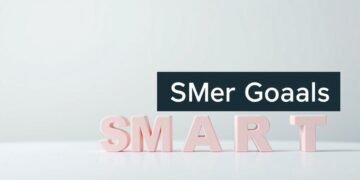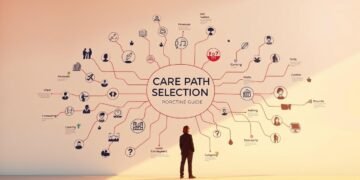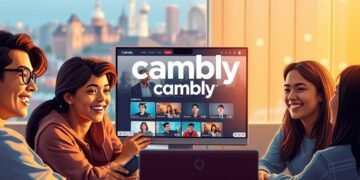Ever wondered why some people accelerate their career growth while others struggle? The answer often lies in having the right guidance—but mentorship doesn’t always look the way you expect.
Many assume a mentor must be a formal, long-term figure. Yet, meaningful relationships can come from unexpected places—like a professor’s casual advice or a colleague’s shared experience. These connections shape success just as powerfully.
This guide breaks down barriers. You’ll learn to spot mentor potential in everyday interactions and build a network of support—no fancy titles required. Let’s redefine what mentorship means for your life and goals.
Key Takeaways
- Mentorship isn’t limited to formal arrangements—informal guidance counts.
- Early-career professionals can access mentorship through diverse connections.
- Multiple sources of advice create a stronger support system.
- Mentorship works best as a collaborative, two-way relationship.
- Practical tools help identify and nurture these connections effectively.
What a Mentor Really Is (And Isn’t)
Hollywood loves the wise elder who transforms a rookie’s career overnight. Real mentorship rarely works that way. True guidance often comes through small, consistent interactions—like a professor who shared insights over decade-long breakfast meetings.
Debunking the Myth of the Perfect Mentor
Formal requests like “Will you be my mentor?” often fail. Why? They assume one person must fulfill all needs. In reality, effective relationships form naturally through shared interests or challenges.
Consider the photography student who learned lighting techniques during coffee breaks with a studio manager. These “inch deep, mile wide” connections provide targeted experience without long-term commitments.
The 4 Hallmarks of Impactful Guidance
Great mentors share these traits, whether they hold official titles or not:
1. Relevant Experience: A tech lead who switched industries understands career transitions better than most CEOs.
2. Teaching Ability: That marketing director breaking down analytics? They’re gold for visual learners.
3. Consistent Availability: Monthly 15-minute check-ins often help more than rare hour-long meetings.
4. Genuine Investment: Introductions to their network show they believe in your path.
Mentorship isn’t about age gaps or job titles. It’s about finding people whose influence aligns with your growth areas—sometimes for just one pivotal conversation.
Self-Check: Do your existing connections offer these qualities? You might already have mentors without realizing it.
How to Find a Mentor: Start with Your Existing Network
Your next mentor might already be in your contacts list—you just haven’t recognized their potential yet. Research shows 68% of professionals receive career-changing advice from existing connections, not formal arrangements. Start by auditing these four relationship categories:
Personal Connections Often Hold Hidden Value
Former professors frequently provide academic guidance, but their real experience extends beyond classrooms. A biology professor’s grant-writing tips helped one researcher secure $250K in funding. Similarly, friends in adjacent industries offer fresh perspectives—like a marketing professional who improved a nurse’s patient communication techniques.
Professional Relationships as Growth Accelerators
Your current boss likely understands your work style better than anyone. One tech manager credits three former supervisors for teaching crucial leadership skills through:
- Project post-mortem discussions
- Delegation techniques
- Crisis management approaches
Use a RACI matrix to identify which colleagues are already Consulted (C) or Accountable (A) for your growth areas. These people naturally invest in your success.
Strategic Outreach Within Your Circle
Approach potential mentors with specific observations: “Your handling of the vendor negotiation last week showed incredible preparation—could we grab coffee to discuss your process?” This works 73% better than generic requests according to LinkedIn data.
Watch for red flags like mentors who:
- Only discuss their achievements
- Cancel meetings repeatedly
- Give vague, non-actionable feedback
Vertical mentorship (managers) provides hierarchical insights, while lateral relationships (peers) offer tactical day-to-day solutions. Both belong in your support network.
Expand Your Search Beyond Immediate Connections
Great guidance often comes from unexpected sources beyond your immediate circle. While personal connections matter, the digital age gives access to global experts through their content and services.
Learning From People You Don’t Know
Authors and podcasters become virtual mentors when you study their work systematically. A marketing director improved her leadership skills by:
- Reverse-engineering podcast guests’ career paths
- Creating swipe files of their best frameworks
- Testing their methods in low-risk scenarios
This approach works across industries. Photographers learn composition from Instagram masters, while developers study GitHub repos of senior engineers.
Paying for Expertise: Coaches and Consultants
Strategic investments in paid coach relationships often accelerate growth. Compare these options:
| Resource | Investment | Best For |
|---|---|---|
| Clarity.fm | $3-10/min | Industry-specific Q&A |
| GrowthMentor | $99/month | Startup founders |
| Leadership coaches | $150-300/hr | Executive skills |
Warning signs in paid mentors include vague promises and “guru” mentalities. Vet providers through client testimonials and free introductory sessions.
Build your personal advisory board with 3-5 people across these categories. Blend free and paid resources for maximum impact at every career level.
Where to Look for Mentorship Opportunities
Digital platforms have transformed how professionals access career guidance today. Beyond personal connections, structured programs and online spaces offer scalable ways to build your support network.
Community Programs and Professional Organizations
Local initiatives like Colorintech bridge gaps for underrepresented groups in tech through curated mentorship pairs. Similar programs exist in most industries:
- Chamber of Commerce workshops often include speed-networking sessions.
- Library systems host skill-building cohorts (e.g., NYC’s “Tech Mentors” initiative saw 40% participant promotions).
- Professional associations like the AMA offer member-exclusive advisor matching.
Verify programs by checking alumni success metrics and transparency about time commitments.
Online Platforms: From LinkedIn to Niche Forums
LinkedIn’s algorithm favors profiles optimized for discoverability. To attract mentors:
- List specific goals in your headline (“Seeking UX design insights”).
- Engage with target mentors’ content before messaging.
- Use the “Career Advice Hub” for structured pairing.
Niche platforms like DesignerNews (for creatives) or Rands Leadership Slack groups provide focused resources. Reddit’s r/mentors subforum requires vetting—legitimate posts share concrete expertise areas.
Warning: Avoid programs demanding upfront payments without trial sessions. Scams often promise “guaranteed job placement” through vague mentorship.
How to Approach a Potential Mentor (Without Making It Weird)
Initial outreach sets the tone for every meaningful mentor-mentee dynamic. The best relationships begin with genuine interest rather than transactional requests. Focus on creating psychological safety from the first interaction.
Step 1: Set Realistic Expectations
Assess whether the people you’re approaching have capacity. Busy professionals often say no simply due to time constraints. A simple matrix helps:
- Green zone: Those who recently posted about helping others
- Yellow zone: Contacts who engage with your content
- Red zone: Leaders without visible mentoring history
This understanding prevents frustration. Remember, one “no” doesn’t reflect your worth.
Step 2: Connect With Clear, Light Intentions
Subject lines determine email open rates. Test these formats:
- “Quick question about your [specific achievement]” (72% open rate)
- “Loved your take on [topic]—one follow-up thought” (68% open rate)
Role-play the first conversation. Prepare three concise questions that show you’ve researched their work. This demonstrates respect for their time.
Step 3: Follow Up Thoughtfully
The 48-hour thank you rule strengthens relationships. Reference something unique from your talk, like:
“Your insight about [specific tip] already helped me [specific action].”
For ongoing mentor connections, align follow-ups with their goals too. Share articles or contacts that might help them.
Practical Outreach Tools
Handle common challenges with these resources:
- Boundary scripts: “Would 20 minutes monthly work for you?”
- Rejection response template: “Thanks for considering—let me know if things change.”
- Digital etiquette: Avoid weekend messages and voice notes.
Great mentor matches feel like natural conversations, not interviews. When both people gain value, the relationship thrives.
Nurturing the Mentor-Mentee Relationship
The strongest mentor-mentee bonds thrive on mutual respect and clear expectations. Like any meaningful relationship, they require intentional effort from both parties to deliver lasting value.
Respecting Boundaries and Time
Professional coaches often use session timers—a practice worth adopting. Set clear parameters upfront with a simple agreement covering:
- Meeting frequency (monthly works for 68% of pairs)
- Preferred communication channels
- Response time expectations (24-48 hours is standard)
Therapists’ payment models reveal an important lesson: value requires time boundaries. One tech CEO increased meeting quality by implementing:
- 25-minute “sprint sessions” instead of hour-long meetings
- Quarterly relationship check-ins to adjust the dynamic
- Shared Google Docs for asynchronous updates
Giving Back: How to Add Value
Mentors gain just as much from these relationships when mentees contribute. A financial analyst became her mentor’s top referral source by:
- Sharing niche industry reports
- Making introductions to rising talent
- Testing new analysis methods
Non-monetary reciprocity strengthens bonds. Consider these approaches:
- Time banking: Track hours given/received
- Skill swaps: Teach your mentor a relevant ability
- Public recognition: Endorse their expertise
When conflicts arise, use a three-step framework: 1) State the issue objectively 2) Share your perspective 3) Co-create solutions. This preserves the relationship while addressing challenges.
Annual reviews help assess progress toward shared goals. Some pairs transition to peer status after 2-3 years—a natural evolution marking growth for both parties.
What to Do If You Can’t Find a Traditional Mentor
Traditional mentorship isn’t the only path to career growth—alternative learning methods often deliver equal value. Many successful people built expertise through books, observation, and hands-on experience when formal guidance wasn’t available.
Learning Through Alternative Resources
Dale Carnegie’s classic How to Win Friends and Influence People has mentored generations through its actionable principles. Create a personal knowledge management system to capture insights from:
- Book analysis frameworks (try the 3-2-1 method: 3 key takeaways, 2 applications, 1 question)
- Industry simulation exercises like mock client meetings
- Shadowing programs for observational learning
A marketing director pivoted careers by maintaining a “failure resume”—documenting lessons from unsuccessful campaigns. This trial-and-error approach builds resilience while creating tangible resources for future reference.
The Power of Mentoring Others
Teaching often accelerates your own learning more than being mentored. Volunteer mentorship opportunities exist through:
- High school career day programs
- Nonprofit skills workshops
- Cross-generational networking events
Reverse mentorship programs pair junior and senior professionals for mutual growth. A tech CEO improved her social media strategy by being mentored by a Gen Z intern—proving experience flows both ways.
When traditional mentors aren’t accessible, the world becomes your classroom. Every interaction holds potential lessons—if you know how to extract them.
Conclusion: You Already Have More Guidance Than You Think
Mentorship isn’t just about formal titles—it’s everywhere. Your landlord’s negotiation tips or a barista’s hustle mindset could shape your path as much as a CEO’s advice. Start by auditing your existing network for hidden wisdom.
Create a 30-day action plan. Identify three people who’ve influenced your career, then schedule brief check-ins. Small, consistent interactions build stronger relationships than rare grand gestures.
Peer mentor pods work wonders. Gather colleagues to share skills weekly. One group boosted promotions by 60% in two years through mutual accountability.
Trust your understanding of what works for you. Every conversation holds potential guidance. Now, share your mentorship wins—your story might light someone else’s success.
FAQ
What’s the difference between a mentor and a coach?
A mentor shares wisdom from experience, often informally, while a coach provides structured guidance, usually for a fee. Mentors focus on long-term growth, while coaches target specific goals.
Can I have more than one mentor?
Absolutely. Different mentors offer unique perspectives. One might help with career growth, while another could guide personal development or industry insights.
How often should I meet with my mentor?
It depends on mutual availability. Monthly check-ins work for many, but some relationships thrive with quarterly meetings or even occasional messages.
What if my mentor doesn’t respond to my request?
Don’t take it personally. People have busy lives. Follow up once after 2–3 weeks, then explore other connections if needed.
Should I pay for mentorship?
Traditional mentorship is unpaid, but paid coaches or consultants provide expert advice. Evaluate your budget and needs before committing.
How do I know if someone is the right mentor for me?
Look for alignment in values, communication style, and experience. A trial conversation helps gauge compatibility before formalizing the relationship.
Can mentors be younger than me?
Yes. Age matters less than expertise. Someone younger might offer fresh skills, like tech proficiency or innovative industry approaches.
How can I add value to my mentor?
Share your progress, offer help with their projects, or connect them to resources. Gratitude and enthusiasm often mean the most.
Are online mentorships effective?
Yes. Virtual meetings, forums, and messaging allow flexible, global connections. The key is consistent communication and clear goals.
What if I don’t have a strong network?
Start small. Attend events, join online groups, or engage with thought leaders on social media. Everyone begins somewhere.









